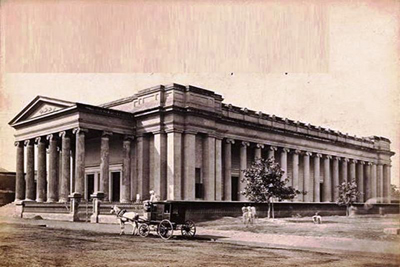
Most of the present generation of Calcutta, especially those who born after 1960s, is unfortunate to miss the beauty and elegance of the imposing building of the Senate House, a part of the University of Calcutta that once stood gracefully before the water body of College Square as a symbolic temple with the mission of spreading higher education in undivided Bengal.


The University of Calcutta was founded on 24 January 1857, with a Senate comprising of .41 members as the policy making body. According to the date of foundation, it was the first institution of higher studies in Asia, established as a multidisciplinary and secular Western-style university, with a catchment area from Lahore to Rangoon, and Ceylon. The land for the foundation of the proposed University was donated by the Maharaja of Darbanga, Maheshwar Singh Bahadur and finally, the Syndicate of the Calcutta University started functioning from 30 January 1858.However, the first meeting of the Senate was held in the Council room of the Calcutta Medical College, as it did not have any office of its own till that time. After a few days, the office of the university temporarily started to operate in a few rented rooms in Camac Street, though a room in the Writers' building was used for several years for holding the meetings of the Senate and Syndicate. According to the old records, the first school leaving examination, known as Entrance Examination, under the university was held in March 1857 in the Town Hall of Calcutta with 244 examinees.

The decision of constructing a building for the university was taken by the Senate in the year 1862 and accordingly the classical styled Senate House building was constructed in 1872, at a cost of 252,221 Rupees. However, it was formally inaugurated on the convocation day of the university on 12 March 1873.
The façade of the massive building with tall Corinthian pillars looked almost like a temple of Greece. It was designed by a leading Victorian architect, Walter B. Granville, who was also the architect of the St James Church, the building of the General Post Office and the Calcutta High Court. The building of the Senate House was so spectacularly splendid, that its picture with its palatial portico and majestic pillars, can be found even today in many books on history, architecture and education. Apart from holding the meetings of the Senate, it housed the official chamber of the Vice-Chancellor, offices of the Registrar and was also used as examination and lecture halls. On 27 December 1934, the first edition of the All Bengal Music conference was held in the hall. A proposal was raised in the same year to add an art gallery and museum in the hall, in connection with post-graduate studies in Ancient Indian History and Culture. Accordingly, the Asutosh Museum of Indian Art was opened in the Western Hall of the Senate House in 1937.
Till it’s unfortunate end, the Senate House remained as the most prominent symbol of the University of Calcutta and one of the distinguished landmarks of the city during the Colonial period. To make way for a new spacious building, the magnificent building was brutally demolished in 1960, by order Dr B C Roy, the then chief minister of the state.
